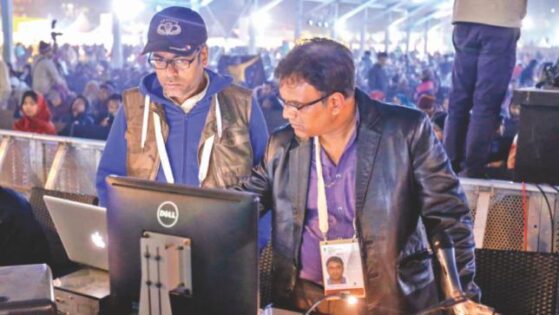
Pramod Sir with the Astana Symphony Philharmonic Orchestra
On the opening night of this year’s Bengal Classical Music Festival, the Dhaka audience experienced something unique: the Astana Symphony Philharmonic Orchestra’s presentation of Western Classical classics like Tchaikovsky’s ballet composition “Swan Lake”, as well as a magnificent blending between Eastern and Western classical music through collaboration between the Orchestra and Carnatic violin virtuoso Dr. L Subramaniam and his ensemble.

Chandorkar (R) busy behind the console
Any discerning listener who has experienced a full orchestral performance would realize how incredible it was to have a 58-piece orchestra with a vast tapestry of sounds play in an open-air venue and still have the same experience of a concert hall with specially-architected acoustics where Western classical is usually performed. This performance underlined one of the most crucial factors behind the success of this festival in the past six years – a crisp, crystal auditory experience whether it is the thundering ghatam and mridangam or the nuanced notes of the santoor. The Daily Star got hold of the chief sound engineer of the concert, Pramod Chandorkar, to find out what goes on behind the mixing console to achieve that.
Mumbai-based Chandorkar, an accomplished sound engineer with 25 years of experience, has been touring the world with Sonu Nigam – one of India’s biggest singing stars – for 15 years. This is his second year working at the festival. “I have worked previously with the London Philharmonic and Birmingham Philharmonic, so I had that sound in my head. I came to Dhaka on December 21 for a private show, and at the time the sound system was being set up here. I came and consulted with the event management here about the setup. And there have been lots of emails and diagrams being emailed back and forth for a while. I carried a lot of microphones with me as well; we needed to use 70-odd microphones for the orchestra. Typically the sound is captured with overhead ‘open’ mics, but because this is an open field, it was capturing the wind so we used closed mics on the violins. We blended the open and closed mics to create the right sound. Western classical musicians do not use stage monitors because they only follow the conductor; for the combined part I had to give them monitor because otherwise, they cannot hear what Dr. Subramaniam and his ensemble is playing. I also heard that car sounds and horns from the road behind were being picked up by the open mics, so I requested the organisers to keep traffic restricted during that performance. All in all, it was quite a complex process, but at the end of it everyone was very happy with it,” he said.
About the overall sound setup of the festival, Chandorkar said “It’s the best in the world. Even in India, this kind of sound is never used for a classical concert, because it is quite expensive. I thank Blues Communications and Bengal Foundation for investing in such a setup for a classical concert. This sound setup can cover absolutely any kind of concert at any kind of venue.”
Chandorkar, who runs a sound engineering academy named Soundideaz in Mumbai, is keen to pass on his expertise. “We have three local sound engineers here working with me, and I am trying to train them with the techniques I use. In a few years, I hope to see Bangladeshi sound engineers handling the entire festival by themselves.”

